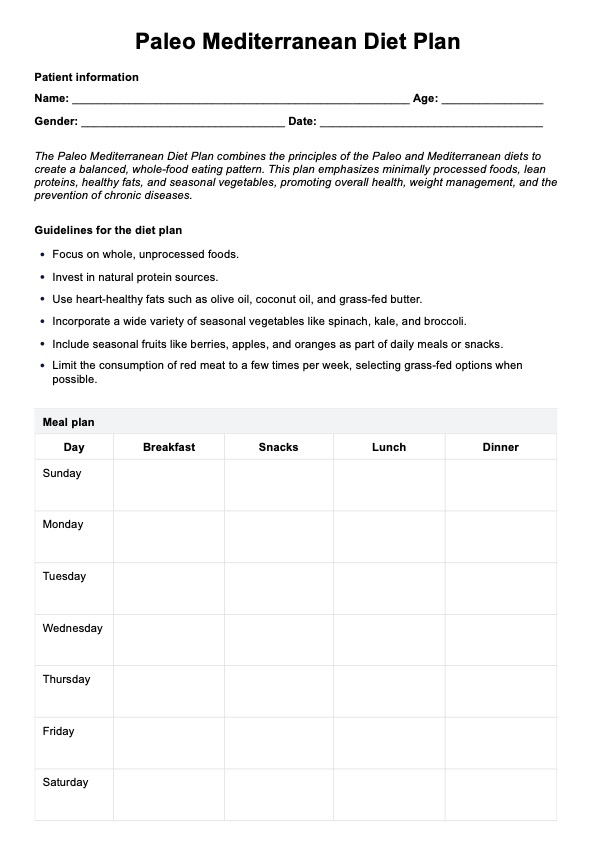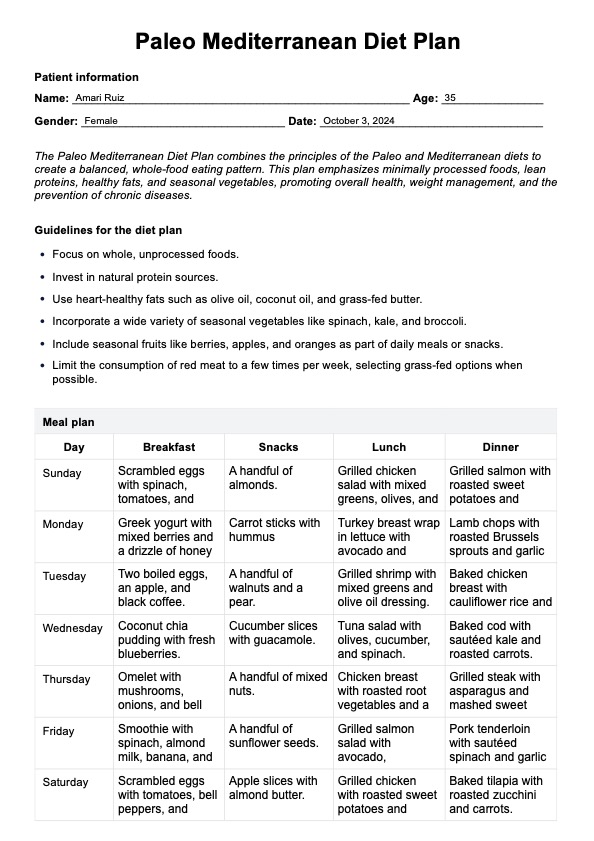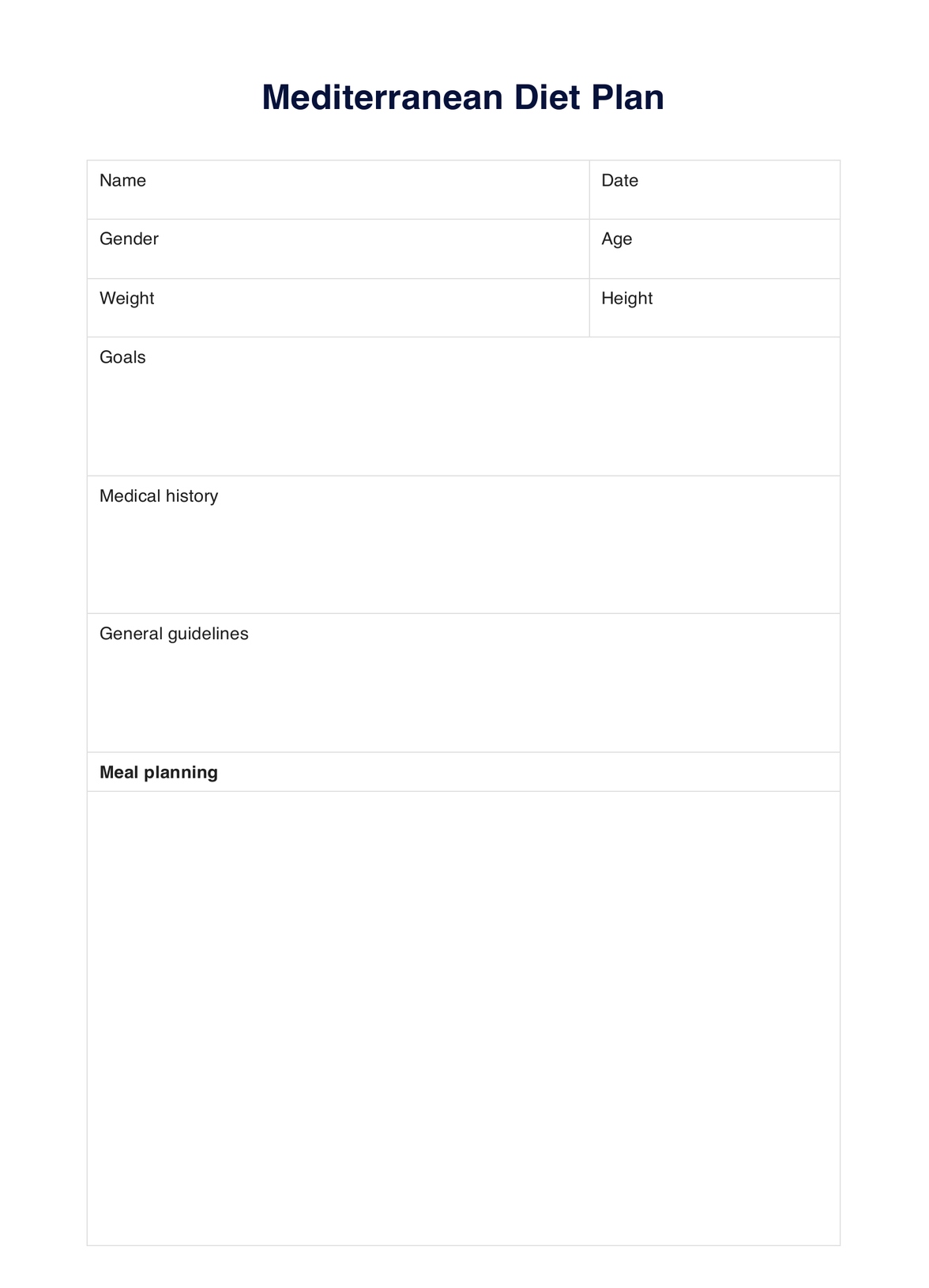Paleo Mediterranean Diet Plan
Provide your clients who want to try the paleo Mediterranean diet with a helpful guide and template they can use as they embark on this new food journey.


The basics of Paleo Mediterranean Diet
The Paleo Mediterranean Diet combines the principles of two popular eating plans—the Mediterranean and Paleo diets—to create a balanced, nutrient-rich approach to nutrition. The Mediterranean diet, traditionally followed by people around the Mediterranean Sea, focuses on whole foods, including vegetables, fruits, whole grains, and healthy fats like olive oil. In contrast, the Paleo diets, often called the Stone Age diet or Caveman diet, encourage eating foods that early humans would have consumed, such as lean meats, fish, and minimally processed foods, while avoiding grains and dairy products.
When comparing the Mediterranean diet vs. Paleo, the Paleo Mediterranean diet combines the best aspects of both and offers flexibility. The Paleo diet consists of cutting out processed foods, legumes, and refined sugars, which aligns well with the Mediterranean's consumption of clean, whole ingredients. Red meat and seafood are consumed in moderation, with coconut oil and olive oil acting as the primary sources of healthy fats.
By combining these two dietary patterns, the Paleo Mediterranean Diet promotes weight loss and improved eating habits and provides many health benefits, including heart health and inflammation reduction. This fusion encourages balanced nutrition from various food
Paleo Mediterranean Diet Plan Template
Paleo Mediterranean Diet Plan Example
The importance of a Paleo Mediterranean Diet Plan
The Paleo Mediterranean Diet Plan is essential for those seeking a balanced and holistic approach to health. It combines the principles of the Mediterranean and Paleo diets. This unique eating style focuses on nutrient-dense, whole foods that support metabolic health and overall well-being. The Mediterranean diet emphasizes minimally processed foods, seasonal vegetables, fruits, whole grains, and healthy fats. In contrast, the Paleo diet cuts out modern processed ingredients such as refined grains, dairy, and chemical food additives.
One of the primary reasons the Paleo Mediterranean Diet Plan is important is its focus on reducing inflammation and improving heart health. By emphasizing healthy fats from fatty fish and avoiding unhealthy vegetable oils and artificial sweeteners, the diet helps regulate cholesterol levels and lower blood pressure. Unlike the more restrictive keto diet, the paleolithic diet promotes the consumption of clean proteins like lean meat and root vegetables, which offer essential nutrients without the side effects of highly processed foods. The Mediterranean diet uses these natural, whole foods to support optimal body function and long-term health.
Moreover, this combined diet approach is ideal for individuals aiming to lose weight and maintain a healthy weight. By reducing the intake of red meat and refined grains while increasing the consumption of nutrient-dense foods, the Paleo Mediterranean Diet Plan enhances metabolic health, providing steady energy and promoting fat loss without sacrificing nutritional variety. Its alignment with traditional eating habits, including using natural ingredients and foods consumed by ancient civilizations, ensures a sustainable and health-conscious lifestyle.
This eating plan is crucial for improving various aspects of health, such as stabilizing blood sugar, managing weight, and supporting cardiovascular health. It is an ideal option for those seeking a natural, effective, and flexible eating style that supports longevity.
How does this diet plan PDF work?
The Paleo Mediterranean Diet Plan PDF is an essential tool for healthcare professionals to guide patients through a structured and effective diet regimen. This step-by-step template simplifies introducing and implementing the Paleo Mediterranean Diet into a patient's routine, ensuring clear communication and goal-setting.
Access the diet plan template
Healthcare professionals can access the Paleo Mediterranean Diet Plan template provided in this guide. The template is designed to help patients easily follow the dietary principles, ensuring they adopt healthy eating habits that align with Paleo and Mediterranean diet philosophies.
Review the content of the diet plan
Once the template is accessed, carefully review the plan's content. It also describes essential food groups and some examples. This helps practitioners educate patients on the balance between minimally processed foods, healthy fats, and proteins like lean meat and red meat in moderation.
Introduce the diet plan to the patient
When introducing the Paleo Mediterranean Diet Plan to the patient, ensure that they understand the core principles and how the diet supports their health goals. Provide a detailed explanation of the meal structure, focusing on the importance of whole foods, seasonal vegetables, and nutrient-dense choices.
Discuss goals and create a diet plan
Engage with the patient to set clear goals and collaborate with them to create a diet plan. Discuss potential outcomes like weight loss, improved metabolic health, and reduced inflammation. Align these goals with their personal health needs, ensuring the patient understands how the diet contributes to long-term wellness.
Benefits of a Paleo Mediterranean Diet Plan
The Paleo Mediterranean Diet Plan offers a variety of health benefits by combining the best elements of both diets. Below are some of the major advantages that this plan provides:
Promotes heart health
The Mediterranean Paleo Diet Plan is rich in heart-healthy fats from sources like grass-fed butter and olive oil. By reducing trans fats and saturated fats, and focusing on unprocessed foods, the diet encourages better cardiovascular health and may lower the risk of heart disease.
Encourages weight management
The diet encourages balanced consumption of certain foods, including lean proteins like chicken breast, healthy fats, and fresh, seasonal fruits. By avoiding processed food and focusing on nutrient-rich meals, it supports sustainable meal plan options that aid in effective weight management.
Reduces chronic disease risk
With its emphasis on whole, unprocessed foods and anti-inflammatory properties, the Paleo Mediterranean Diet Plan helps reduce the risk of chronic diseases such as type 2 diabetes, obesity, and certain cancers. This eating pattern supports healthier dietary habits and contributes to long-term well-being.
Enhances overall eating patterns
This meal plan promotes better eating patterns by eliminating highly processed foods and encouraging whole, natural options like vegetables, fruits, and lean meats. Following these dietary habits leads to a more balanced lifestyle, free from the negative effects of processed ingredients.
Supports sustainable energy levels
The Mediterranean Paleo Diet Plan emphasizes whole foods and lean proteins like chicken breast and seasonal fruits, providing steady energy throughout the day. By minimizing processed sugars and refined carbohydrates, the diet helps maintain stable blood sugar levels, enhancing daily performance and stamina.
Commonly asked questions
Yes, there is. It combines the principles of the Paleo diet with the heart-healthy traditional Mediterranean diet.
Compared to the Mediterranean diet, AIP is more restrictive and focuses on reducing or managing inflammation. Meanwhile, the former focuses on lowering heart disease risk and improving overall health.
Yes, eggs are a part of both the Mediterranean and paleo diets, making them a good food choice for the Mediterranean paleo diet.











































































































